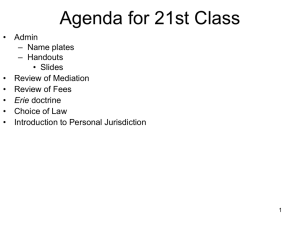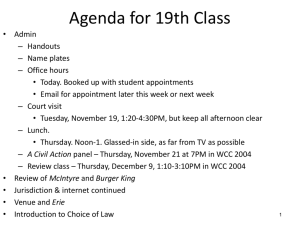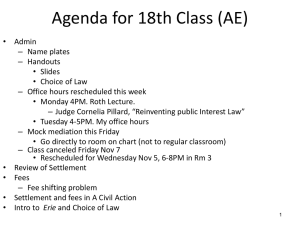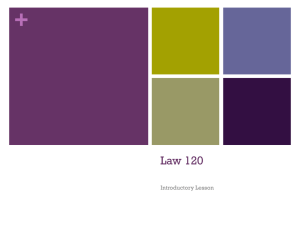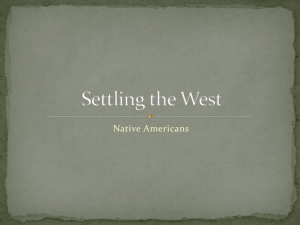Erie
advertisement
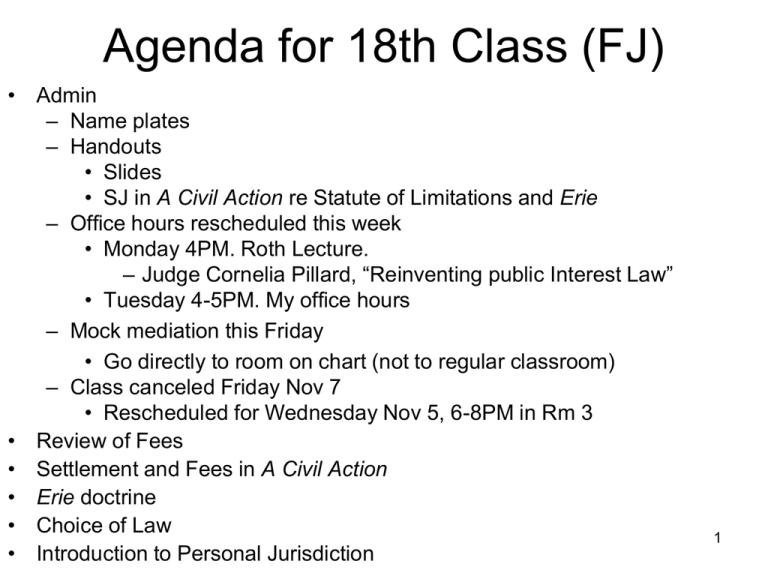
Agenda for 18th Class (FJ) • Admin – Name plates – Handouts • Slides • SJ in A Civil Action re Statute of Limitations and Erie – Office hours rescheduled this week • Monday 4PM. Roth Lecture. – Judge Cornelia Pillard, “Reinventing public Interest Law” • Tuesday 4-5PM. My office hours – Mock mediation this Friday • Go directly to room on chart (not to regular classroom) – Class canceled Friday Nov 7 • Rescheduled for Wednesday Nov 5, 6-8PM in Rm 3 • Review of Fees • Settlement and Fees in A Civil Action • Erie doctrine • Choice of Law • Introduction to Personal Jurisdiction 1 Assignment • • Friday – Mock Mediations – No writing assignment Monday – Read SJ in A Civil Actions re Statute of Limitations and Erie • You don’t need to read it very carefully • Personal Jurisdiction: International Shoe & early cases – FRCP 4(k), especially 4(k)(1)(A) – Yeazell, 79-91 – Writing Assignment/ Questions to think about » Briefly summarize International Shoe » If the Supreme Court had not decided to change the rules in International Shoe, would jurisdiction have been proper under the prior rules? If your answer is “yes,” why do you think the Supreme Court changed the rules? If you answer is “no,” why was the outcome under the new rules better? » Yeazell pp. 86ff. Qs 1b, 3 » Briefly summarize McGee and Hanson 2 – Optional: Glannon Chapters 1 & 2 Review of Fee Shifting • Advantages of British Rule – Allows plaintiffs to bring meritorious (high probability) cases, even when litigation costs are high. See Example 11. – Discourages plaintiffs from bringing frivolous (low probability) suits. See Examples 15. • Disadvantages of English Rule – Public interest litigation to change the law may be deterred, because it has a low probability of succeeding, even though it is not “frivolous.” – Risk averse plaintiffs may not bring even meritorious suits. Example 14. – Because of the way the English Rule magnifies optimism, it may discourage settlement. See Example 16. • Although risk averse parties may be more likely to settle under British rule 3 How Are Lawyers Paid? • 3 ways lawyers are paid – Hourly fee. (most common for defense) – Contingent fee (most common for plaintiffs • Lawyer gets nothing if loses; gets percentage (now usually 40%) of any amount the plaintiff wins – Salary. (most common for government or public interest lawyers) – When party who hired lawyer on contingent fee or salary is entitled to lawyer’s fees, then courts estimate hourly rate (lodestar method) – Fees and costs are usually folded into settlement amount – But, if not mentioned specifically in settlement agreement, then prevailing party can still claim costs 4 Settlement and Fees in A Civil Action • In what ways does A Civil Action confirm the validity of Polinsky’s economic model of settlement? • In what ways does A Civil Action contradict Polinsky’s economic model of settlement or suggest that the real world is more complex than that model? • Given the settlement, how did they calculate how much Schlichtmann and the other lawyers received? 5 Erie Doctrine I • Swift v. Tyson (1841)(Story). Federal courts apply state statutes in diversity cases, but do not need to follow state court decisions on common law. State court decisions are only “evidence” of “general principles of commercial law,” and federal courts are free to develop common law as they see fit • Erie RR v. Tompkins (1938) (Brandeis) – RR accident. Issue is whether to apply PA court decisions, defendant may be liable only for “williful or wanton injury” (not mere negligence) – Rejects Swift v Tyson. Federal courts apply common law as interpreted by state courts • Usually that means as interpreted by state court in state in which federal court is located, but see next class on choice of law. – Swift gives out-of-state citizens unfair advantage, because they can choose either state law (by suing in state court) or federal law (by suing in federal court) – Congress does not have the power to make commercial law. Nor do the federal courts. (probably wrong now) – Swift makes jurisprudential mistake of assuming that there is a “transcendental body of law outside of any particular State” 6 • Influence of legal realism Erie Doctrine II • Guaranty Trust v. York (1945)(Frankfurter) (not assigned) – Federal court must apply state statute of limitations, which was shorter, because statutes of limitations are “outcome determinative” – Law is not “brooding omnipresence of Reason” – Don’t draw (formalistic) line between substance and procedure – Instead, ensure that “outcome of litigation in the federal court [is] substantially the same, so far as legal rules determine the outcome of a litigation, as it would be if tried in State court.” – State statutes should be disregarded only if they concern “merely the manner and means by which a right to recover is … enforced.” 7 Erie Doctrine III • Hanna v. Plumer (1965) – FRCP 4 applies in federal court rather than narrower state statute – FRCP are authorized by federal statute, Rules Enabling Act, and apply in federal court, regardless of contrary state court rule, • as long as rule is constitutional and governs the “practice and procedure of the district courts,” and is thus authorized by the statute – Every rule or practice is potentially “outcome determinative” – For federal practices • Consider policies behind Erie – Discourage forum shopping – Avoid “inequitable administration of justice” • What is “federal practice”? – Procedure not in FRCP or federal statutes – Example: standards of review • Modern trend. Apply federal rules and practices in federal court 8 Erie Questions • • Suppose West Dakota has a summary judgment practice different from the that which has governed in the federal courts since Celotex. In West Dakota, a defendant may not prevail by pointing out that plaintiff lacks evidence on an issue, but rather the defendant can only prevail on summary judgment by presenting undisputed evidence on every issue. If a diversity case is filed in federal district court in West Dakota, what standard should apply if the defendant files a motion for summary judgment? Federal courts have a policy of encouraging mediation. One aspect of that policy is that neither the parties nor the mediator can be compelled to reveal what was said in mediation. In addition, a mediator’s proposal is immune from disclosure. That is, if, at the end of the mediation, the mediator suggests what she thinks is a fair settlement, those settlement terms are confidential and cannot be revealed to a judge or jury. The federal policy is not embodied in the Federal Rules of Civil Procedure or Federal Rules of Evidence, but is part of case law at the appellate level in most circuits, including the Fourteenth Circuit, which includes East Dakota. East Dakota state courts have no such policy. Judges are free to ask questions of lawyers about mediation. Some find it useful to ask, “what was the mediator’s proposal?” Judges use that information in a variety of ways. Some use it as the starting point for their own settlement conferences; they encourage the parties to agree to the mediator’s proposal or something similar. Some take a more aggressive approach and implicitly threaten lawyers, “if you don’t accept the mediator’s proposal, I’ll make sure evidentiary and other rulings go against you.” Judge Fred, a federal district court judge in East Dakota, thinks that the East Dakota state court’s approach is the correct one, because mediation is so useful that no one in her right mind would refuse mediation because she feared disclosure of the mediator’s proposal. Patty sued David for breach of contract in federal court in East Dakota. The parties went through an unsuccessful mediation. May Judge Fred compel Patty and David to reveal the mediator’s proposal? (from 2011 exam) 9 Choice of Law Questions I • 1) Suppose Wes, a resident of West Dakota, gets into an accident with East, a resident of East Dakota, on a highway in West Dakota. Wes sues East in West Dakota state court alleging per se negligence because East was driving 79 miles per hour. No speed limit was posted. West Dakota law states that, unless otherwise posted, the speed limit on a highway is 70 miles per hour. East Dakota law, however, states that, unless otherwise posted, the speed limit on a highway is 80 miles per hour. Which state’s law applies to this dispute? Is your answer different under the traditional lex loci commissi rule than under the Restatement Second? If your answer is different, which rule makes more sense? • 2) Same as (1) except Wes sues in West Dakota federal district court. • 3) Same as (1) except Wes sues in East Dakota state 10 court. Choice of Law Questions II • 4) Driver and Passenger are both domiciled in West Dakota. Driver drives passenger to East Dakota. While in East Dakota, Driver talks on his cell phone and causes an accident in which Passenger is injured. Passenger sues Driver in West Dakota state court for negligence. According to East Dakota law, passengers have no right to sue drivers for injuries caused by negligence. According to West Dakota law, passengers can sue drivers for negligence. Which state’s law applies to this dispute? Is your answer different under the traditional lex loci commissi rule than under the Restatement Second? If your answer is different, which rule makes more sense? • 5) Same as (4), except Passenger sues in West Dakota federal court. • 6) Same as (4) except Passenger sues in East Dakota state court. 11 Choice of Law Questions III • 7) Spend, a Nevada domiciliary, is completely irresponsible with money. Fortunately, he recognizes this fact and has set up a spendthrift trust. Under the terms of the trust, Spend cannot borrow money without the consent of Trustee, a friend he trusts. Spend goes to California and borrows money there from Sharkey to be repaid in one year at Sharkey’s place of business in California. When Spend doesn’t repay the loan, Sharkey sues Spend in Nevada. Under Nevada law, loans to someone who has set up a spendthrift trust are void. California law does not allow people to set up spendthrift trusts, so under California law, such loans are enforceable. The traditional rule for contracts was the law of the place the contract was formed governs disputes about contract validity. Under the traditional rule, what state’s law would apply? Under the Restatement Second, which state’s law should apply to the dispute? If the traditional rule and Restatement Second suggest different answers, which makes more sense? • 8) Same as (7), except Sharkey sues in California state court. • 9) Same as (8), except Sharkey traveled to Nevada, loaned Spend the money there, with repayment to be made to Sharkey when he returns to Nevada a year later. 12 Choice of Law Questions IV • 10) Same as (7), except the loan contract includes the following clause: “This contract shall be governed by California law.” The traditional rule was not to enforce choice of law clauses. See also Restatement (Second) below • § 187. Law Of The State Chosen By The Parties • (1) The law of the state chosen by the parties to govern their contractual rights and duties will be applied if the particular issue is one which the parties could have resolved by an explicit provision in their agreement directed to that issue. • (2) The law of the state chosen by the parties to govern their contractual rights and duties will be applied, even if the particular issue is one which the parties could not have resolved by an explicit provision in their agreement directed to that issue, unless either – (a) the chosen state has no substantial relationship to the parties or the transaction and there is no other reasonable basis for the parties' choice, or – (b) application of the law of the chosen state would be contrary to a fundamental policy of a state which has a materially greater interest than the chosen state in the determination of the particular issue and which, under the rule of § 188, would be the state of the applicable law in 13 the absence of an effective choice of law by the parties. Choice of Law Questions V • Plaintiff in Phillips brought the case in federal district court in Montana. Why is there a decision of the Supreme Court of Montana? • In Phillips, the Montana Supreme Court observes that “applying the law of the place of manufacture would be unfair because it would tend to leave victims under compensated as states wishing to attract and hold manufacturing companies would raise the threshold of liability and reduce compensation…. [A state with a high concentration of manufacturing] could enjoy all the benefits associated with liability laws which favored manufacturers in order to attract and retain manufacturing firms and encourage business within its borders while placing the costs of its legislative decision, in the form of less tort compensation, on the shoulders of nonresidents injured by its manufacturers’ products.” (p. 249). – Suppose Montana has a relatively low concentration of manufacturing. Would its citizens benefit by laws which raised the threshold of liability and reduced compensation? Or would its citizens benefit by laws which lowered the threshold of liability and increased compensation? If it lowered the threshold of liability and increased compensation, who would bear the increase in costs? What does this suggest about the fairness of applying Montana law? 14 Choice of Law Questions VI • In Phillips, the Montana Supreme Court asserted that “we do not believe that the purpose of any potentially applicable Michigan product liability law would be to regulate the design and manufacture of products within its borders. The purpose of product liability law is to regulate interstate sales or sales to residents and to set the level of compensation when residents are injured. ” (p. 249) – If the plaintiffs in Phillips had filed the case in Michigan state court, do you think Michigan state judges would have agreed that its laws are inapplicable? What purpose might a Michigan judge ascribe to product liability law to show that Michigan law should apply? • If you were a judge on the Montana Supreme Court, would you have retained the traditional lex loci commissi rule, or would you have voted (like the actual Montana Supreme Court) to adopt the Restatement (Second) most significant relationship approach? Why? 15 Introduction to Personal Jurisdiction • Personal jurisdiction is about which court can hear a case – If case is in state court, personal jurisdiction answers question “which state court?” • California state court? Massachusetts state court? – If case is in federal court, personal jurisdiction answer question “federal court in which state?” • Federal court in California? Federal court in Massachusetts? – Contrasts • Subject matter jurisdiction. Federal or state court? • Venue. Which court within a state – Los Angeles superior court or San Francisco superior court – C.D. of California (federal court in LA) or N.D. California (federal court in San Francisco) 16 Long-Arm Statutes • Court must have statutory or rule authority AND statute or rule must be constitutional – Structure is similar to • Service of Process. Need statutory/rule authority AND statute/rule must be constitutional • Subject matter jurisdiction. Need statutory authority AND statute must be constitutional – State statutes are generally called “Long Arm Statutes” • Enumerated Act statutes – E.g. statute says, State court has jurisdiction over defendant if it is a citizen of the state, if it committed a tort in the state, if it was a party to a contract to be performed in the state… • To the Limit of the Constitution statutes (CA) – Federal rule is FRCP 4(k)(1)(A) • Federal courts generally apply state long-arm statute applicable to court of “general jurisdiction – “Court of general jurisdiction” means non-specialized court with power to hear big cases (e.g. superior court), not family court, small claims court or other specialized court – Course will focus on constitutional limitations 17 • Due Process clause Rules before International Shoe (1945) • Pennoyer v Neff (1877) • 3 bases for personal jurisdiction – In personam. If defendant is citizen or resident of state, or present in state, or consented to jurisdiction • For individuals, extreme case was service of process in airplane over Arkansas. Grace v. MacArthur (1959) • Corporations are citizens in state where incorporated (e.g. Delaware) • Difficult to determine where corporation is “present” – Where headquartered. Clearly yes – Where has plant or office and lots of employees. Clearly yes – What if only has a few employees? Not clear – Where does business? Unclear what means to “do business” – In rem. In dispute about property, personal jurisdiction is proper where property is located – Quasi in rem. If suit is NOT about property, but defendant has property in state, plaintiff can sue in that state for whatever cause of action, but recovery is limited to value of property in state 18
